Miscellaneous Cool Things
It seems to me that I sometimes spend too much time grumbling about things that don't work or don't work the way I think they should, but sometimes I encounter some real winners. I've been tossing some of those into a directory and this week I thought I'd share them with you.
Calling a Bug a Bug
Several years ago, Bill Gates commented that Microsoft Software didn't have bugs. New versions of the operating system and applications were enhancements or improvements, but they weren't bug fixes. That, of course, is absurd. All software has bugs.
Each time the e-mail program I use has a new version, the developers provide a list of what has changed in The Bat and they are careful to differentiate between enhancements, new features, and bug fixes.
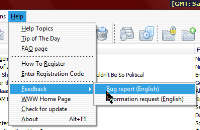 In fact, they even allow common users like me to report bugs. For example, when I noticed that a bug in the latest version of the program causes the Delete function to fail, I decided to report it.
In fact, they even allow common users like me to report bugs. For example, when I noticed that a bug in the latest version of the program causes the Delete function to fail, I decided to report it.
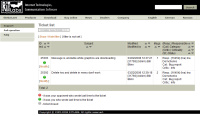 To report a bug, I needed to provide the serial number of the program that I use and also provide my e-mail address. RIT Labs already has my e-mail address, but this makes it easy for the software engineers to ask questions if they have any.
To report a bug, I needed to provide the serial number of the program that I use and also provide my e-mail address. RIT Labs already has my e-mail address, but this makes it easy for the software engineers to ask questions if they have any.
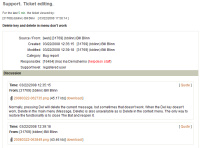 I filled out a bug summary and included a screen capture to illustrate the problem.
I filled out a bug summary and included a screen capture to illustrate the problem.
Bug report: Normally, pressing Del will delete the current message, but sometimes that doesn't work. When the Del key doesn't work, Delete in the main menu (Message, Delete) is also unavailable, as is Delete in the context menu. The only way to restore the functionality is to close The Bat and reopen it.
Having a Warranty That's Worth More than the Paper It's Not Printed On
You probably know that my primary computer is from TCR Systems in Pickerington. Several months ago the year-old system suffered some unexplained problems. TCR replaced memory, a hard drive, and finally everything but the box that the computer is in (and I mean everything: even the power supply). They also carefully moved all of the data from the old hardware to the new. My cost for all of this was zero because TCR offers a 3-year warranty on many of its systems.
And it's encouraging when I receive a message such as this one because it clearly illustrates that TCR treats all of its customers the same way:
I sent another friend who needed a laptop to TCR, and they were delighted with their new computer and the service. My friend asked Warren about mailing in a warranty card, and he said "If you have any problems, you bring it right here to me!"
TCR built a desktop for my sister last year, and she has been very happy with it. She was impressed with a company that actually listens to what their customers need instead of trying to push old inventory like the big box stores. They also helped her out by installing AVG's free version and some good free anti spyware programs, which is a big help to people who would otherwise spend a lot of money for branded programs with a lot of unnecessary features that were functionally no better than the excellent available freeware.
Using a Laptop Without Making Your Lap Hot
I had foot surgery a couple of months ago and was required to sit with my foot propped up for a week or so. This is not a position that is conducive to sitting at a computer desk. Although I have laptop computers (one Windows/Linux machine and one Mac OS X machine) using them can be painful because of the heat they emit from the bottom. The Mac particularly. Its aluminum case radiates enough heat to produce a burn.
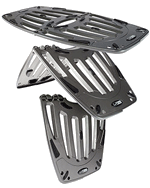 Fortunately, I had a LapWorks Laptop Desk and that made working solely with laptop computers for a couple of weeks much more manageable than it would have been otherwise. The desk is a hinged plastic device that folds down to about 11 by 11 inches (small enough to fit in most computer cases) and opens up to about 21 by 11 inches (enough for all but the largest laptop computer and a mouse). It provides stability, a space for the mouse, and protection from heat. That's not bad for a $30 device.
Fortunately, I had a LapWorks Laptop Desk and that made working solely with laptop computers for a couple of weeks much more manageable than it would have been otherwise. The desk is a hinged plastic device that folds down to about 11 by 11 inches (small enough to fit in most computer cases) and opens up to about 21 by 11 inches (enough for all but the largest laptop computer and a mouse). It provides stability, a space for the mouse, and protection from heat. That's not bad for a $30 device.
Since then LapWorks has upgraded the Laptop Desk to the Futura model. The size remains the same, but some of the corners are a bit more rounded and air channels that were previously closed are now open so that air flow is better. If you use a laptop at the office, the Laptop Desk Futura can be set up in a way that makes it easier to use. But you might also want to look at the company's desk stands that range in price from $25 to $100.
What's in a Word 2007 File?
Matthew Stevens, a friend in Australia reported that a colleague had set Word 2007 to save files by default in doc (Word 2003) format. She then zips the doc file and e-mails that to Matthew. When he unzips the file, he receives several additional pieces that appear to be part of the Word 2007 (docx) file format. I thought he needed a tinfoil hat, but it turned out that extra pieces are there and that they're visible only if you use an unzip program that doesn't know about docx files. Oh—and you have to do it on a Mac, too. So maybe it's me who needs the tinfoil hat.
I blustered: I'm not sure that I understand the process being described here. If you are saying that the doc file contains what's in the docx file (what I originally thought), that simply cannot be the case because earlier versions of Word wouldn't know what to do with the file. On the other hand, if you're saying that the process of zipping the file somehow adds the additional stuff that would have been in the docx file to the zip (that is, outside the doc file, but included in the zip file) I can't see how that would happen, but at least it would allow the doc file, once unzipped, to be opened by earlier versions of Word.
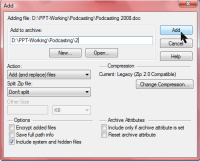 I sent Matthew, and Dick Margulis, another friend who owns PCs, two zipped files: 1.zip was a zipped docx file and 2.zip was a zipped doc file. I also included the docx file with a zip extension. The explanation for that is below. I asked them both to examine the files.
I sent Matthew, and Dick Margulis, another friend who owns PCs, two zipped files: 1.zip was a zipped docx file and 2.zip was a zipped doc file. I also included the docx file with a zip extension. The explanation for that is below. I asked them both to examine the files.
Here is some additional background information. This is the WinZip dialog for creating 2.zip (the doc file). Notice there is nothing up my sleeve.
 After the zip archive was created, it contained a single file:
After the zip archive was created, it contained a single file:
![]() Next, let's examine the doc and docx files with a hex editor (UltraEdit). Note that the docx file begins with the letters PK. This is a marker (PK Zip) that indicates the file is a zip archive.
Next, let's examine the doc and docx files with a hex editor (UltraEdit). Note that the docx file begins with the letters PK. This is a marker (PK Zip) that indicates the file is a zip archive.
 Now let's look at the doc file. No PK marker. Nothing has been zipped.
Now let's look at the doc file. No PK marker. Nothing has been zipped.
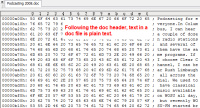 Now let's scroll down a bit in the doc file. We should soon begin to seen plain text because that's the way doc files store text:
Now let's scroll down a bit in the doc file. We should soon begin to seen plain text because that's the way doc files store text:
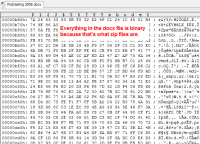 Zip files, by definition, are binary. Nothing in the file should be human readable and, indeed, it is not:
Zip files, by definition, are binary. Nothing in the file should be human readable and, indeed, it is not:
Finally, let's take a different view of that docx file. I've claimed that it's simply a zip archive, but I haven't proven it. I'll start by making a copy of the file:

 Now I'll rename the copy docx to zip.
Now I'll rename the copy docx to zip.
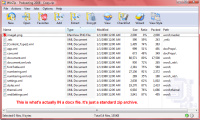 And then I'll open the file with WinZip.
And then I'll open the file with WinZip.
Applying Logic (Not Always a Good Idea with Software)
I'm still mulling this over and here's my thought process so far (the coffee is on, but I haven't had any yet):
- Nothing happens on a computer by magic. All functions are created by programmers working with what must still be viewed as primitive tools.
- For a zip archive to contain more than the files specified by the user, a program will need to locate these files and store them.
- The extra files are useless, so my first question is why anyone would spend valuable resources programming it.
- How does it know where the files are? This goes back to #1. You have a docx file and you save it as a doc file. You might have saved it in the same directory, but you also might have saved it to a network drive or to a thumb drive that you then took to another computer. How does the zip archiver know where to find the extra files? What does it do when it can't find them because they're on a device that's no longer connected to the computer?
- This would be a process that's guaranteed to fail in many cases and it would therefore require a lot of additional analyst time to develop the use case and an inordinate amount of programmer time to code, test, and debug. Yet the additional files (point 3) would not be needed.
If you can find out exactly what steps the user takes to create the zip archive, that might be helpful.
I know that Microsoft products, when creating HTML files, generate a main HTML file and then place all of the subsidiary files in a subdirectory. The operating system, by default, will treat these as a single entity, much the way (OS X) Macs treat an app file, which is really just a directory that contains files and possibly other directories.
As far as I know, this behavior is not implemented for other kinds of files and, even if it had been, I keep coming back to the "how does it know where the original file is so that it can get the extra components?"
I conducted one more test. After copying all of the files to a thumb drive, I examined them on a Mac running OS X 10.5 (Leopard). Here are the 3 files.
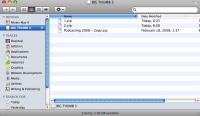
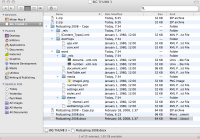 I double-clicked each of the files to extract the contents. 1.zip produced a single file 2.zip produced a single file Podcasting 2008 - Copy.zip (this, remember, is the docx file renamed with a zip extension) produced a directory.
I double-clicked each of the files to extract the contents. 1.zip produced a single file 2.zip produced a single file Podcasting 2008 - Copy.zip (this, remember, is the docx file renamed with a zip extension) produced a directory.
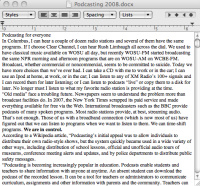
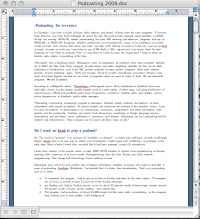 Just to see what would happen, I double-clicked the docx file and it opened in TextEdit.
Just to see what would happen, I double-clicked the docx file and it opened in TextEdit.
Then I did the same for the doc file.
I don't know if this gives you any additional clues, but there you have it.
Comments from Dick Margulis
I switched from a flat file view to a folder view of the zip file. Then I clicked the Word folder. Then I dragged document.xml (all by its lonesome) into Word 2003 (patched with the .docx adapter, so this might not work with an unpatched version) in page layout view.
Innerestin'.
Also note that the .docx contents are all undated (showing as 1/1/1980 12:00), including aforementioned document.xml, which is the content of Bill's document.
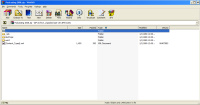
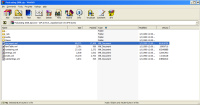
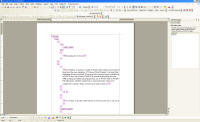
I've had two cups of coffee, and here's my hypothesis: Matthew's client, trying to be helpful, grabbed both the .doc and .docx versions of the document and zipped them up together. Ockham's razor suggests this is the likeliest scenario.
Comments from Matthew Stevens (in blue)
I was too tired on the weekend to make sense of anything (red lights gave me trouble), which is why I have not responded sooner. And work keeps getting in the way.
I have just spoken to my colleague. She opens a file sent to her in .doc format, she works on it, she saves it. Word 2007 keeps it in .doc format throughout. At no stage does she save a file in .docx format and then tell Word 2007 to Save As .doc. She then goes to WinZip and specifies the .doc file. It zips, and she sends me that file.
I unzip the file and get a standalone .doc file and a folder. I've trashed (and wiped) the zip file so I can't send you a screen shot, but your files did exactly the same thing (below, or separately attached; not sure how well Eudora handles in-line graphics).
Here is a screen shot of the results of unzipping the 3 files and the contents of the folders (without expansion). The zip files are colour-coded for discrimination. Note that I got 3 folders and 2 documents:
As expected, my Word 2004 did not recognise the .docx file. The OS recognised it as a zip file.
Here is some additional background information. This is the WinZip dialog for creating 2.zip (the doc file). Notice there is nothing up my sleeve.
That trick never works! (Keep that up and the creators of Rocky and Bullwinkle will want royalties!)
3. The extra files are useless, so my first question is why anyone would spend valuable resources programming it.
Probably not intentional.
1.zip produced a single file
2.zip produced a single file
Podcasting 2008 - Copy.zip (this, remember, is the docx file renamed with a zip extension) produced a directory.
Interesting. The difference could be due to the zip expander each of us uses. I usually use Stuffit. Let me try with the OS X built-in one ... Hmm. Very interesting. The OS X expander (called BOMArchiveHelper) creates a single file and no folder - which is what you got. My Stuffit is version 10.0.2, copyright 2005, before .docx was released, so it can't know about the .xml files. So where does it find them?
The Thought Plickens
Clearly part of the problem is Stuffit, because Apple's built-in expander gets it right and so do the various Windows expanders we've tried.
I sent Matthew a Word 2003 document that had never been opened by Word 2007. He reported:
I just expanded it by both methods (BOMArchiveHelper and Stuffit Expander) and each produced 1 file and no folders.
Arrrrrrgh!
Something Impossible This Way Comes
This can't be happening, but it is. As part of the final test (after which I give up) I converted the file that I sent to Matthew to Word 2007 format and saved it to the hard drive. I then saved the docx file as a doc file in the same directory as the docx file.
I now have two copies of the doc file: One that has never been sullied by Word 2007 and one that was converted to docx and then back to doc. I also have an application called Beyond Compare that can examine documents byte by byte to see what differences are present.
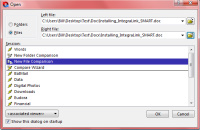
It can't be happening, but it is.
A "standard" doc file that has been created in or edited in Word 2007 will contain additional data that is not needed by Word 2003, but that is apparently discarded by Word 2003 on Windows machines. Macs detect the additional information and display it even though it has no business being there.
The additional information isn't particularly apparent near the top of the file ...
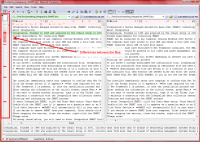
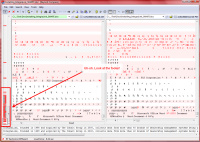 ... but look what happens in the footer (at the right)! There's a large area of differences.
... but look what happens in the footer (at the right)! There's a large area of differences.
So Matthew was correct. I was wrong. I still can't see any logical reason why Microsoft decided to implement this in the way they did, except possibly to retain information that will be needed to restore missing functionality should the document be opened again in Word 2007. In fact, that actually makes sense: Someone at Microsoft had the foresight in Office 2003 to create markers that tell Word 2003 to ignore entire sections of the file and then to use these sections of the file to retain information needed by Office 2007.
And it took a Mac to blow their cover!
Nerdly News
What Happens if You Steal a Police Car?
Depending on what jurisdiction you're in, what radio system the police have, and how the radio systems are wired into the cruisers, maybe something. Maybe nothing. So you could hop into a cruiser, hit the lights and siren, and go for a little ride. It wouldn't be a good idea, but you could do it. In another jurisdiction, you could hop into a cruiser, hit the lights and siren, and find that your little ride stops after a few seconds because headquarters sent a kill message through the radio to the cruiser's ignition. Theoretically, you could set the system up to lock the doors, too, but that probably introduces enough liability issues that no city attorney would approve it. Cruisers are sometimes stolen. So are notebook computers, including those owned by the FBI, ATF, military, and probably even the CIA. Intel is working on a way to make notebook computers safer.
About 2,000,000 laptops are stolen every year. That's according to the FBI. Around 15% of all companies have reported at least one stolen notebook computer within the past year. So Intel is working on anti-theft technology (ATT) to prevent notebook computers from being stolen and to protect the data on the computer if it is stolen. ATT will start showing up on Intel-based systems this year as part of the company's active management technology.
An Intel scientist says that the new technology will make it possible to turn the PC off under certain conditions. The system will also make it possible for the computer to report its location if it's connected to the Internet (physically or via Wi-Fi) and all data on the disk can be encrypted. This protects the data even if a thief removes the hard drive and places it in another machine.
ATT will be turned off by default because Intel doesn't want a repeat of what happened when it included a unique identifier in the original Pentium III CPUs. Security and privacy are always at odds with each other. In that case, privacy won and the unique identifiers were disabled.
Ubuntu 8 (Hardy Heron) Is Ready to Fly
Within 2 weeks, the next version of the Ubuntu Linux operating system will be released. Hardy Heron takes over from Gutsy Gibbon (7.10) and I haven't yet finished reading the manual for 7.10. If you're fed up with Windows but you don't want a Mac, maybe a free operating system is for you. My usual warning still applies: If there are Windows applications that you must have, you probably need a Windows machine; if there are Mac applications that you must have, you probably need a Mac. There are ways to run multiple operating systems on a single machine, but it's challenging. Still, for many people Hardy Heron may be what's needed.
Ubuntu continues to improve the feature set and functionality. Some of the new features include:
- Xorg 7.3 to make Ubuntu better able to use more monitors and multiple monitors, along with other hardware. If you've stayed away from Linux because you need to run presentations on an external monitor, you might find that Linux will now function the way you need it to.
- GNOME has been updated and now makes it possible to trash, pause and undo file operations, and escalate user privileges on an ad hoc basis. The speed of some operations is also reported to be better.
- Better audio.
- Firefox 3 (currently in beta, soon to be generally available). Firefox isn't part of Ubuntu, but it's closely associated with Ubuntu because both are open source projects.
- Improved CD and DVD burning capabilities.
- A built-in world clock applet that allows you to keep track of what time it is in various parts of the world.
- Uncomplicated Firewall (ufw), a new host-based firewall application that can be configured from the command line. The goal was to make firewall administration easier for end users while giving network administrators the control they need.
The Weekly Podcast
Podcasts are usually in place no later than 9am (Eastern time) on the date of the program. The podcast that corresponds to this program is below. The most recent complete podcast is always located here.
Search this site: Looking for something you remember hearing about on TechByter Worldwide? Search me.
Subscribe to the newsletter: Subscribing to the podcast: I recommend Apple's Itunes for podcasts. Itunes will also install the latest version of QuickTime. The program is free. Need instructions?
Privacy Guarantee: I will not sell, rent, loan, auction, trade, or do anything else with your e-mail address. Period.
How the cat rating scale works.
Do you use a pop-up blocker? If so, please read this.
The author's image: It's that photo over at the right. This explains why TechByter Worldwide was never on television, doesn't it?
Feed the kitty: That's one of them on the left. Creating the information for each week's TechByter requires many hours of unpaid work. If you find the information helpful, please consider a contribution. (Think "NPR".)


